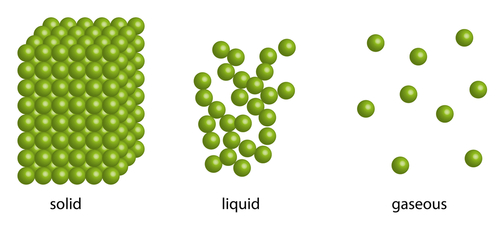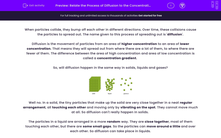When particles collide, they bump off each other in different directions. Over time, these collisions cause the particles to spread out. The name given to this process of spreading out is 'diffusion'.
Diffusion is the movement of particles from an area of higher concentration to an area of lower concentration. That means they will spread out from where there are a lot of them, to where there are fewer of them. The difference between the area of high concentration and area of low concentration is called a concentration gradient.
So, will diffusion happen in the same way in solids, liquids and gases?

Well no. In a solid, the tiny particles that make up the solid are very close together in a neat regular arrangement, all touching each other and moving only by vibrating on the spot. They cannot move much at all. So diffusion can't really happen in solids.
The particles in a liquid are arranged in a more random way. They are close together, most of them touching each other, but there are some small gaps. So the particles can move around a little and over each other. So diffusion can take place in liquids.
The particles in gases are much freer, and move around much more and much faster than in liquids. The particles in a gas are spread out much further than in liquids or solids. Diffusion happens really quickly in gases as gas particles are spaced far apart and also because they bump into each other more often, sending particles of substances flying in all directions, helping them to spread out!
Have you got your head around all that?

Great! Then let's take a look at a few questions.







